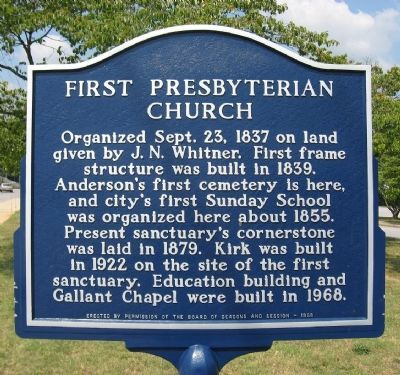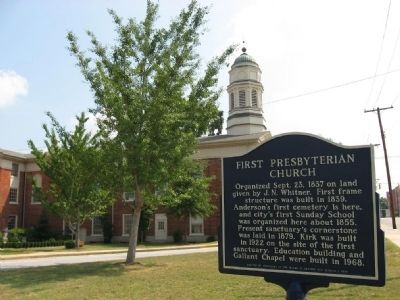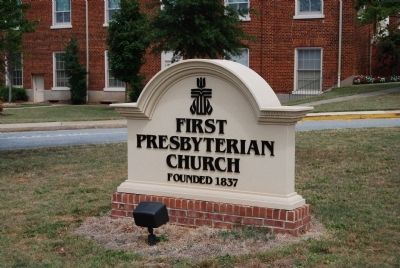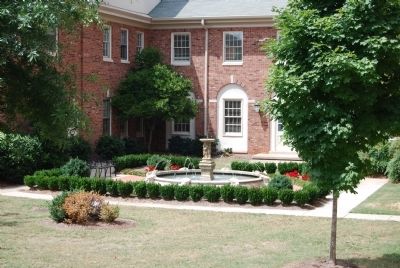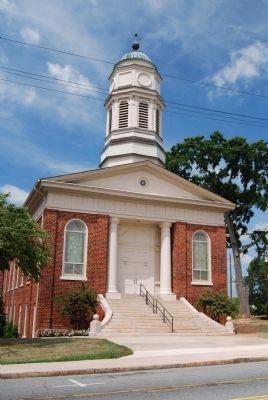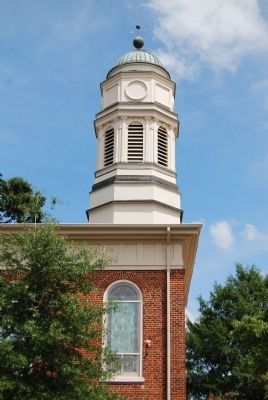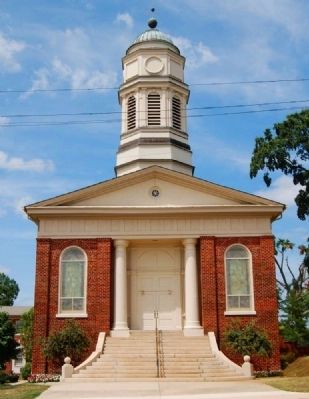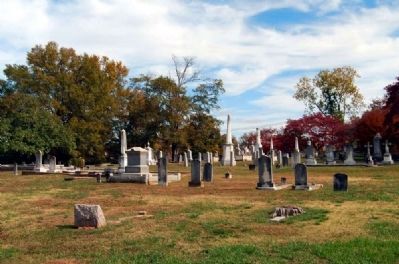Anderson in Anderson County, South Carolina — The American South (South Atlantic)
First Presbyterian Church
Organized Sept. 23, 1837 on land given by J. N. Whitner. First frame structure was built in 1839. Anderson's first cemetery is here, and city's first Sunday School was organized here about 1855. Present sanctuary's cornerstone was laid in 1879. Kirk was built in 1922 on the site of the first sanctuary. Education building and Gallant Chapel were built in 1968.
Erected 1968 by Board of Deacons and Session.
Topics. This historical marker is listed in this topic list: Churches & Religion. A significant historical date for this entry is September 23, 1986.
Location. 34° 30.179′ N, 82° 39.244′ W. Marker is in Anderson, South Carolina, in Anderson County. Marker is on West Whitner Street (State Highway 24) west of Towers Street. Touch for map. Marker is at or near this postal address: 302 W Whitner St, Anderson SC 29624, United States of America. Touch for directions.
Other nearby markers. At least 10 other markers are within walking distance of this marker. Anderson Presbyterian Church Cemetery (about 300 feet away, measured in a direct line); In This Burial Ground (about 300 feet away); Thompson Centennial United ME Church -- 1867 (approx. 0.2 miles away); Anderson County Confederate Monument (approx. 0.2 miles away); Anderson County Law Enforcement Officers Memorial (approx. 0.2 miles away); Anderson: "The Electric City" (approx. 0.2 miles away); William Church Whitner (approx. ¼ mile away); Anderson County Court House -- 1898 (approx. ¼ mile away); The Four Way Test (approx. ¼ mile away); Sullivan Hardware Co. -- 1875 (approx. ¼ mile away). Touch for a list and map of all markers in Anderson.
Additional commentary.
1. Joseph Newton Whitner (1799-1864)
Joseph Newton Whitner was a judge, one of the founders of Anderson, and one of the signers of South Carolina's Secession Ordinance.
Whitner was born on April 13, 1799 near Pendleton Village of Joseph and Elizabeth Shackleford Whitner. He was brought up in Pendleton Court House, however. Whitner was 61 years old in 1860. His face was dominated by a proboscis behind which lay large, pensive eyes. Joseph Whitner had been a state representative (1826-1830) and senator (1830-1835). While there, he helped pass legislation creating Anderson District from part of Pendleton District. After his years in the general assembly, the judge became Solicitor of the Western District and eventually a major general of cavalry in the militia.
In his younger years, however, Whitner sometimes had been on the other side of the law. One day while at school in Union village, Joseph Whitner was visited by the deputy sheriff of the district on some relatively minor matter. Apparently unknown to the officer, young Joseph Whitner carried a pistol to school. The deputy intended to arrest him, and the future solicitor pulled his firearm out, jokingly telling the officer that he would not go willingly. When the deputy jumped off of his horse in rage, Whitner came very close to shooting the peace officer.
Whitner continued his education, however, and after graduating from South Carolina College in 1818, he learned the law by reading it. Elected a law judge of 1850, he left his excitable temper outside the courtroom. On the bench his demeanor made him a lawyer's dream com true: the judge was conscientious, patient, kind, and courteous to the attorneys before him. Sometimes Judge Whitner's fear of making an unfair ruling made him appear hesitant and doubtful. (Source: Rebellion in the Temple of Justice: The Federal and State Courts in South Carolina During the War Between the States by William Moise (2003) pg 94.)
A supporter of slavery, Whitner believed that slavery humanizes the character of the master only when it comes up to biblical standards. He owned close to sixty slaves. Many took the name Whitner upon their emancipation. (Source: The Most Boisterous Passions: Southern Responses to Thomas Jefferson’s Critique of Slavery by Eugene D. Genovese.)
— Submitted June 15, 2009, by Brian Scott of Anderson, South Carolina.
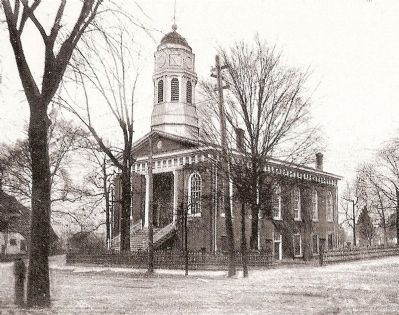
South Carolina Postcards, Vol. IX: Anderson County, by Howard Woody, circa 1908
9. First Presbyterian Church
The first small frame structure facing Tolly Street was erected in 1837 with a membership of 13. A larger building was erected facing Whitner Street in 1839. The cornerstone to their brick sanctuary shown above was laid in 1879. Rev. S.J. Cartledge was the pastor in 1903.
Credits. This page was last revised on December 9, 2021. It was originally submitted on August 20, 2008, by Ronald Miller of Gray Court, South Carolina. This page has been viewed 2,318 times since then and 20 times this year. Last updated on August 25, 2008, by Brian Scott of Anderson, South Carolina. Photos: 1, 2. submitted on August 20, 2008, by Ronald Miller of Gray Court, South Carolina. 3, 4, 5, 6. submitted on August 26, 2008, by Brian Scott of Anderson, South Carolina. 7. submitted on June 15, 2009, by Brian Scott of Anderson, South Carolina. 8. submitted on November 13, 2011, by Brian Scott of Anderson, South Carolina. 9. submitted on June 15, 2009, by Brian Scott of Anderson, South Carolina. • Kevin W. was the editor who published this page.
